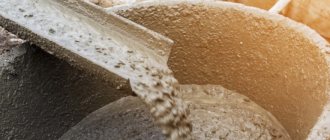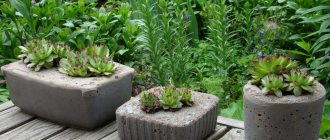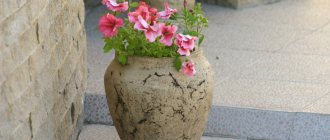In order for the summer cottage to have an attractive appearance and be practical, it is necessary to create paths. Walking through swamps and dry land is inconvenient, and maintaining order in the area will be much more difficult. Concrete paths are another matter; they allow you to walk around the site even during rain, create an attractive landscape design, and significantly increase the practicality of the area. At the same time, making paths at the dacha with your own hands from cement is not so difficult. You will have to work a little and invest some money, but everything will definitely work out. The main thing is to adhere to the technology and pay enough attention to each stage.
Technology for creating paths on a summer cottage from cement
It’s not just that for many summer residents, DIY cement garden paths have become an excellent choice. There are many materials on the market to do this job. The paths are made of natural wood, paved with stone and paving slabs, and gravel and brick are used. But more often than not, a path made of cement and sand becomes the best option. The main advantages include the fact that the cement path is strong and durable, the materials are inexpensive and can be delivered by your own car, and you can prepare the correct solution with your own hands. To achieve a positive result, you need to do the work in stages.
Track service life and manufacturing cost calculation
The service life of concrete paths in stone packages depends on compliance with installation rules. The coating is durable and strong, with a service life of up to 10 years. All costs for laying concrete stones are covered.
The cost of laying concrete paths in packages under stone depends on the prices for building materials in a particular region. The final cost is also affected by the thickness of the concrete layer and the area of the garden path. 1 cu. m. of road with an area of 10 sq. m. m. thickness 10 cm) costs an average of 3.5 thousand rubles. It should be noted that purchasing ready-made concrete with delivery often costs 30-40% less.
Installation of formwork
In order to get a path of the desired width, height and shape, you need to create formwork. We have already outlined the perimeter; it is made in the form of a thread that is stretched between the pegs. The formwork should run along this perimeter; it acts as a barrier that prevents the solution from spreading to the sides until it hardens completely. Each summer resident finds his own way to make a cement path with his own hands, but most often old boards are used.
The boards are installed around the perimeter and secured with metal reinforcement or small pegs. It is necessary to obtain a trench of the correct shape, on the sides of which there are boards. You can pour concrete into this trench, level it and wait for it to completely harden. It is better to make the height of the formwork in accordance with the height of the path you need, while installing boards on both sides using a level. In this case, you will already have ready-made beacons, along which it is very convenient to level the cement mixture with a rule or a flat board.
Decoration
Cured concrete looks unattractive. To refresh it, they resort to decor. You can do this in any way convenient for you.
Painting
One of the easiest options for freshening up a walkway is painting. To do this, you need to wait until the cementing process of the solution is completed and use acrylic dyes to turn the surface into a work of art. You can do volumetric painting so that the color covers not only the surface, but also penetrates inside. In this case, the dye must be added to the solution during the mixing process. The color will be more resistant to abrasion.
Did you know? The composition of modern concrete (cement based) was discovered in 1844.
Using forms and stencils
You can create a concrete path that resembles laid paving stones. A special plastic mold is used for this. It allows you to make any drawing. Modern stencils make it possible not to interrupt the process of creating paving stones. The form is filled with ordinary concrete mortar, after which after 10–15 minutes it can be moved to another area . The elapsed time is enough for the material to set.
Using this method, with little time, effort and money, you can create a path from elements that imitate expensive tiles or paving stones. Stencils, which are rubber mats with a pattern, are also in demand. They are applied 45 minutes after pouring the solution and the pattern is pressed using a cardboard tube.
Stamping
Stamped concrete is a common material with decorated embossing, which is applied using special stamps. This option for decorating trails is also very popular, as it requires minimal costs. You can choose different patterns: brick, stones, animal skin, animal tracks or their silhouettes, plant motifs. It is applied the next day after concreting the path using a special stamp.
Creating the ideal solution and reinforcement
You need to figure out which cement is best for paths in the country and how to reinforce the future structure. The reinforcement process is often ignored; summer residents miss this stage, but the strength of the structure is much lower. Reinforcement can be done using wire, pipes, fittings. The ideal option would be a special grid with 10x10 cells. This layer will create a more monolithic path; it will withstand high loads and will not crack.
Before pouring a cement path at your dacha, you need to prepare a good solution. It is the solution that determines what result you can achieve at the end of the work. In order to create the solution, you need to prepare a mixing container, a pick-up shovel, cement, sand and water. In order to significantly simplify your task, you can rent a concrete mixer, so the work will be completed several times faster, and the quality of the solution will only increase. But if you want to fill a small path, you can mix the solution with your hands in a container.
In order to get a good mixture, it is necessary to use cement grade M500 or M400. To obtain the desired consistency and strength characteristics, it is necessary to add 3 parts sand and 0.5 parts water to 1 part cement. After thorough mixing, the consistency of thick sour cream should be obtained. The amount of water can be adjusted to achieve the desired consistency. With such proportions you will get heavy cement, but it is convenient to work with.
Preparing the base
The main load from concrete falls on the soil, on the surface of which the concrete solution is laid.
The old path, which has been walked on for many years, does not require special preparation. A small layer of sand will help level the base. This preparation will simplify the procedure for laying bags of concrete. The new site needs more thorough preparation. The compacted surface can withstand any load. When carrying out compaction, different methods can be used. When manually tamping, boards, logs, and metal sticks are used. This option is recommended to be used only if it is necessary to prepare a small area. If the track area exceeds 30 square meters. m., it is recommended to rent a vibrating plate. Sometimes for high-quality pressing of sand it is necessary to pour in a large amount of water. This option is considered budget.
Decorative part
If you want your own cement path to be more original and attractive, you can use different techniques for its construction. The entrance includes various available materials, and the rich imagination of the summer resident is turned on. While the cement has not completely hardened, you can make patterns on the surface using a stencil, which will allow you to achieve the effect of paving slabs. After the formwork is dismantled, you can install curbs on the sides of the path or decorate these places with bricks.
The technology of constructing paths from cement in bags is very popular today. Creating a stone path from cement in bags is quite easy. The prepared solution is poured into small bags, after which they are laid out along the perimeter of the marked path. When the solution hardens, the bags are burned with a burner and a relief surface of the original shape is obtained. Moreover, in each individual case the result will be unique.
Necessary materials
A sidewalk path can consist of different materials. Concrete, stone, gravel, slabs, brick, sand - this is not a complete list of possible coatings. Each material has its own positive and negative characteristics. Today we will get acquainted with concreting technology. Using concrete is a cheap, quick way to make paving.
A certain composition of materials for preparing the solution is common:
- Cement is the main component that connects all components. Portland cement has high bonding properties and is best suited for mortar. In terms of strength, grade 500 is more suitable; grade 400 can be used, but the difference may affect the service life. Be sure to pay attention to dryness and flowability; the cement should not look damp or crumpled.
- Sand. The size of the fractions corresponds to values from 1.5 to 5 mm. The total mass must be uniform, the discrepancy should not be more than 2 mm. The sand must be taken clean, without foreign impurities. The ideal option is river water; it is more expensive, but it does not contain clay or other impurities. If you doubt its purity, sift it.
- Main components of concrete.
Crushed stone. The strength of the solution is given by the aggregate - crushed stone, gravel. You should not use sea stone; it is polished with water and does not have sufficient grip. The size of crushed stone varies from 8 to 35 mm. As with sand, the aggregate should be free of dust, dirt and clay impurities. When preparing concrete, select a filler yourself, consisting of fractions of different sizes, or combine large and medium crushed stone. When mixing components, such dimensions will ensure a tight bond between each other and will not cause the formation of voids.
- The necessary fluidity and viscosity of concrete will be provided by additives and plasticizers. Carefully study the instructions for using the additives included in the solution.
Return to contents
Care instructions
To extend the service life of a concrete pavement, it should be treated annually with hydrophobic agents. You should not use an iron shovel to clear snow in winter. Even if the path is slightly icy, it should be sprinkled with sand, but not salt. Otherwise, the coating will begin to crumble over time.
For garden alleys, concrete is a reliable material at an affordable price. And self-paving and decorating concrete paths will make them an original addition to the landscape design of your yard.
Final events
The formwork with pegs is removed a few days after the work is completed. The remaining small gaps and holes in the ground are masked using concrete and waterproofing additives. After this, the side parts of the path are carefully cleaned, covered with earth and compacted. After 5-10 days the path is suitable for use. Paths in gardens and courtyards are often decorative elements, so they can be given an unusual appearance. Often, to decorate them, they use imitation of natural stone, chaotic or ordered pressing of pebbles, painting, laying out patterns with pieces of tile, etc. If the path is planned to be used infrequently, then it can be made in the form of separately poured slabs of the desired shape. Affordable and practical to use, concrete has gained popularity in organizing garden areas and personal plots.
Design
The correct layout will ensure comfort for the owner of the plot when working in the garden. For example, short concrete paths dividing a plot of land into small fragments visually reduce the total area.
It is advisable to build long paths to avoid such visibility, so the area will seem more spacious. You can look at the photos of concrete paths for examples and note the important and attractive points for yourself.
The design of the tracks must first be completed on a sheet of paper. In this case, you need to take into account:
- convenient routes;
- landscape features;
- existing buildings;
- plantings.
It is not necessary to observe the exact scale and subtleties of the relief. You can draw everything schematically, as long as every detail is clear.
You should not lay a concrete throne through the lowlands; it is advisable to bypass them along a beautiful route. The lines of the paths should create an impressive picture, their configurations should make you want to endlessly stroll along them.
Walking along a winding path, every turn should surprise you with something special: a sculpture, an ornamental plant, etc.
Pouring into molds
The method of pouring mortar into plastic molds makes it possible to produce products that imitate natural stone, paving stones, and elements with original designs and various laying forms. Such stencils can be purchased at a specialized hardware store or market.
You can make formworks from slats yourself. To do this, the slats must be connected to each other in the intended order.











